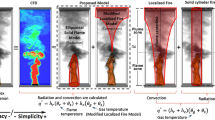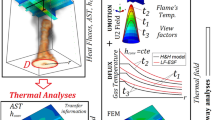Abstract
This article presents a comparative study to predict the thermal behavior of an offshore topside structure under localized fire using different fire models. Thermal fields are estimated using models with different approaches. Sophisticated fire models based on computational fluid dynamics (CFD) are often used in the analysis of this type of accident. However, their high complexity and calculation time make it difficult to use in the design stage of the structure. Simple models usually offer lower temperatures than those estimated by the CFD-FEM model, with limited use in structures with complex geometries. Localized fire with ellipsoidal solid flame (LF-ESF) model was developed as an alternative to previous models that are excessively complex (CFD based) or estimate lower temperatures (Simple). LF-ESF model can evaluate in the design stage the thermal behavior of steel structures under localized fires with the appropriate accuracy in acceptable computation time. The thermal analysis is developed with the aid of commercial software of finite elements. Three case studies are analyzed considering localized fire due to the burning of hydrocarbons. The first two develop the thermal analysis in simple structures and show the main differences between each fire model considered. The last case study evaluated the thermal behavior of an offshore topside structure. The results obtained allow to conclude that the LF-ESF model realistically represents the temperature fields generated by the fire with a relatively low computational cost as compared to the CFD models.










Similar content being viewed by others
Abbreviations
- \( b \) :
-
Characteristic plume radius (m)
- \( c_{p} \) :
-
Specific heat (J/g K)
- \( e_{{{\text{r}},{\text{abs}}}}^{{\prime \prime }} \) :
-
Radiant energy absorbed (kW/m2)
- \( e_{{{\text{r}},{\text{emi}}}}^{{\prime \prime }} \) :
-
Radiant energy emitted (kW/m2)
- \( e_{{{\text{r}},{\text{inc}}}}^{{\prime \prime }} \) :
-
Radiant incident energy (kW/m2)
- \( e_{{{\text{r}},{\text{ref}}}}^{{\prime \prime }} \) :
-
Radiant energy reflected (kW/m2)
- \( g \) :
-
Gravitational acceleration (m/s2)
- \( h_{\text{tot}}^{\text{AST}} \) :
-
Net adiabatic heat transfer coefficient (kW/m2 K)
- \( h_{\text{conv}} \) :
-
Convective heat transfer coefficient (kW/m2 K)
- \( k \) :
-
Thermal conductivity (W/mK)
- \( m^{{\prime \prime }} \) :
-
Burning rate per unit area (kg/m2 s)
- \( q_{\text{conv}}^{{\prime \prime }} \) :
-
Convective heat flux (kW/m2)
- \( q_{f} \) :
-
Heat release rate per unit area (kW/m2)
- \( q_{\text{tot}}^{{\prime \prime }} \) :
-
Net heat flux (kW/m2)
- \( q_{\text{rad}}^{{\prime \prime }} \) :
-
Radiant heat flux (kW/m2)
- \( r \) :
-
Radial distance to flame axis (m)
- \( \bar{r} \) :
-
Normalized flame axis distance
- \( t_{\text{d}} \) :
-
Fire decay time for NFSC curve (s)
- \( t_{\text{g}} \) :
-
Fire growth time for NFSC curve (s)
- \( t_{s} \) :
-
Fire constant behavior time for NFSC curve (s)
- \( z \) :
-
Height of the selected point (m)
- \( z_{o} \) :
-
Height of the virtual source (m)
- \( A_{\text{fs }} \) :
-
Free surface area of the pool fire (m2)
- \( D^{*} \) :
-
Plume characteristic diameter (m)
- \( D \) :
-
Equivalent diameter (m)
- \( E_{\text{av}} \) :
-
Flame average emissive power (kW/m2)
- \( E_{\text{b}} \) :
-
Black body emissive power (kW/m2)
- \( E_{\text{fl}} \) :
-
Flame emissive power (kW/m2)
- \( F_{ij} \) :
-
Geometric view factor
- \( H_{\text{c}} \) :
-
Height of the compartment (m)
- \( H_{\text{fl}} \) :
-
Flame height (m)
- \( \bar{H}_{\text{fl}} \) :
-
Normalized height
- \( {\text{HRR}} \) :
-
Heat release rate (kW)
- \( R^{*} \) :
-
Numerical grid spatial resolution
- α s :
-
Absorptivity
- \( \beta \) :
-
Mean beam length corrector
- \( \delta x \) :
-
Characteristic length
- \( \varepsilon_{\text{s}} \) :
-
Surface emissivity
- \( \varepsilon_{\text{fl}} \) :
-
Flame emissivity
- \( \theta_{\text{AST}} \) :
-
Adiabatic surface temperature (K)
- \( \bar{\theta }_{{\left( {\omega ,t} \right)}} \) :
-
Normalized temperature
- \( \theta_{\text{fl}} \) :
-
Real flame temperature (K)
- \( \theta_{\text{fl,eq}} \) :
-
Equivalent flame temperature (K)
- \( \theta_{\text{g}} \) :
-
Gas temperature (°C, K)
- \( \Delta \theta_{o} \) :
-
Plume centerline temperature (°C)
- \( \theta_{\text{s}} \) :
-
Exposed surface’s temperature (°C, K)
- \( \theta_{\infty } \) :
-
Ambient temperature (K)
- \( \kappa \) :
-
Absorption–extinction coefficient of the flame (1/m)
- \( \rho \) :
-
Specific mass (kg/m3)
- \( \rho_{\infty } \) :
-
Air density (kg/m3)
- \( \sigma \) :
-
Stefan–Boltzmann constant (kW/m2 K4)
- \( \tau \) :
-
Atmospheric transmissivity
- \( \varphi \) :
-
Fire intensity coefficient
- \( \chi_{\text{r}} \) :
-
HRR’s radiant fraction
- \( \chi_{\text{lum}} \) :
-
Percentage of visible flame
- \( \omega \) :
-
Dependent variable (Eq. 14)
- \( \Delta H_{{{\text{c}},{\text{eff}}}} \) :
-
Combustion specific heat (kJ/kg)
References
Hurley MJ, Gottuk DT, Hall JR Jr, Harada K, Kuligowski ED, Puchovsky M, Torero JL, Watts JM Jr, Wieczorek CJ (2016) SFPE handbook of fire protection engineering, 5th edn. SFPE Springer-Verlag, New York. https://doi.org/10.1007/978-1-4939-2565-0
Manco MR, Vaz MA, Cyrino JCR, Landesmann A (2013) Behavior of stiffened panels exposed to fire. In: Analysis and design of marine structures - Proceedings of the 4th International Conference on Marine Structures, MARSTRUCT 2013, pp 101–108. https://doi.org/10.1201/b15120-16
Manco MR, Landesmann A, Vaz MA, Cyrino JCR (2016) Numerical model for analysis of offshore structures subjected to pool fires. Mar Syst Ocean Technol 11:19–29. https://doi.org/10.1007/s40868-016-0014-y
Manco MR, Vaz MA, Cyrino JCR, Landesmann A (2018) Ellipsoidal solid flame model for structures under localized fire. Fire Technol 54:1505–1532. https://doi.org/10.1007/s10694-018-0750-y
American Bureau of Shipping (2013) Guidance notes on a accidental load analysis and design for offshore structures. https://ww2.eagle.org/content/dam/eagle/rules-and-guides/current/other/197_accload/accidental_load_gn_e.pdf
International Maritime Organization (2001) Guidelines on alternative design and arrangements for fire safety
Quintiere JG (2006) Fundamentals of fire phenomena, Wiley. https://doi.org/10.1002/0470091150
McGrattan K, Hostikka S, McDermott R, et al (2015) Fire Dynamics simulator, User’s Guide
Shokri M, Beyler CL (1989) Radiation from large pool fires. J Fire Prot Eng 1:141–149. https://doi.org/10.1177/104239158900100404
Heskestad G (1984) Engineering relations for fire plumes. Fire Saf J 7:25–32. https://doi.org/10.1016/0379-7112(84)90005-5
Heskestad G, Hamada T (1993) Ceiling jets of strong fire plumes. Fire Saf J 21:69–82. https://doi.org/10.1016/0379-7112(93)90005-B
Wickström U (2016) Temperature calculation in fire safety engineering, 1st edn. Springer, Switzerland. https://doi.org/10.1007/978-3-319-30172-3
Wickström U (2011) The adiabatic surface temperature and the plate thermometer. Fire saf sci 10:1001–1011. https://doi.org/10.3801/IAFSS.FSS.10-1001
McGrattan K, Hostikka S, McDermott R, et al (2015) Fire dynamics simulator, technical reference guide, 6.2 edn, vol 1: Mathematical Model, vol 2: Verification Guide, vol 3: Validation Guide
Silva JCG, Landesmann A, Ribeiro FLB (2016) Fire-thermomechanical interface model for performance-based analysis of structures exposed to fire. Fire Saf J 83:66–78. https://doi.org/10.1016/j.firesaf.2016.04.007
Zhang C, Silva JG, Weinschenk C et al (2016) Simulation methodology for coupled fire-structure analysis: modeling localized fire tests on a steel column. Fire Technol 52:239–262. https://doi.org/10.1007/s10694-015-0495-9
Zhang C, Li GQ (2012) Fire dynamic simulation on thermal actions in localized fires in large enclosure. Adv Steel Constr 8:124–136
Heskestad G (1983) Virtual origins of fire plumes. Fire Saf J 5:109–114. https://doi.org/10.1016/0379-7112(83)90003-6
Alpert RL (1972) Calculation of response time of ceiling-mounted fire detectors. Fire Technol 8:181–195. https://doi.org/10.1007/BF02590543
European committee for Standardizaion (2002) EN 1991-1-2: Eurocode 1: Actions on structures: Part 1-2: General actions—Actions on structures exposed to fire. Br Stand Inst
Zhang C, Zhang Z, Li GQ (2016) Simple vs. sophisticated fire models to predict performance of SHS column in localized fire. J Constr Steel Res 120:62–69. https://doi.org/10.1016/j.jcsr.2015.12.026
Muñoz M, Planas E, Ferrero F, Casal J (2007) Predicting the emissive power of hydrocarbon pool fires. J Hazard Mater 144:725–729. https://doi.org/10.1016/j.jhazmat.2007.01.121
Rebec A, Plešec P, Kolšek J (2014) Pool fire accident in an aboveground LFO tank storage: thermal analysis. Fire Saf J 67:135–150. https://doi.org/10.1016/j.firesaf.2014.05.022
Zhang C, Usmani A (2015) Heat transfer principles in thermal calculation of structures in fire. Fire Saf J 78:85–95. https://doi.org/10.1016/j.firesaf.2015.08.006
Mudan KS (1984) Thermal radiation hazards from hydrocarbon pool fires. Prog Energy Combust Sci 10:59–80. https://doi.org/10.1016/0360-1285(84)90119-9
Manco MR (2016) Numerical model for thermomechanical analysis of structures sumitted to pool fire (in Potuguese). Federal University of Rio de Janeiro
Byström A, Cheng X, Wickström U, Veljkovic M (2013) Measurement and calculation of adiabatic surface temperature in a full-scale compartment fire experiment. J Fire Sci 31:35–50. https://doi.org/10.1177/0734904112453012
Byström A, Cheng X, Wickström U, Veljkovic M (2012) Full-scale experimental and numerical studies on compartment fire under low ambient temperature. Build Environ 51:255–262. https://doi.org/10.1016/j.buildenv.2011.11.010
European committee for standardizaion (2005) EN 1993-1-2: Eurocode 3: Design of steel structures: Part 1-2: General rules—Structural fire design. Br Stand Inst 2:
Wen JX, Kang K, Donchev T, Karwatzki JM (2007) Validation of FDS for the prediction of medium-scale pool fires. Fire Saf J 42:127–138. https://doi.org/10.1016/j.firesaf.2006.08.007
Loy YY, Rangaiah GP (2018) Surrogate modelling of net radiation flux from pool fires in a hydrocarbon storage facility. Process Saf Environ Prot 114:296–309. https://doi.org/10.1016/j.psep.2017.12.024
Fernandes Oliveira RL, Doubek G, Vianna SSV (2019) On the behaviour of the temperature field around pool fires in controlled experiment and numerical modelling. Process Saf Environ Prot 123:358–369. https://doi.org/10.1016/j.psep.2018.12.031
Xin Y, Filatyev SA, Biswas K et al (2008) Fire dynamics simulations of a one-meter diameter methane fire. Combust Flame 153:499–509. https://doi.org/10.1016/j.combustflame.2008.01.013
Wickström U, Hunt S, Lattimer B et al (2018) Technical comment-Ten fundamental principles on defining and expressing thermal exposure as boundary conditions in fire safety engineering. Fire Mater 42:985–988. https://doi.org/10.1002/fam.2660
Wickström U (1994) The plate thermometer: a simple instrument for reaching harmonized fire resistance tests. Fire Technol 30:195–208. https://doi.org/10.1007/BF01040002
Ingason H, Wickström U (2007) Measuring incident radiant heat flux using the plate thermometer. Fire Saf J 42:161–166. https://doi.org/10.1016/j.firesaf.2006.08.008
Reddy JN (2004) An introduction to nonlinear finite element analysis, Oxford. https://doi.org/10.1093/acprof:oso/9780198525295.001.0001
Dassault Systèmes Simulia, Fallis A., Techniques D (2013) ABAQUS documentation. Abaqus 6.12 53:1689–1699
Wickström U, Anderson J, Sjöström J (2019) Measuring incident heat flux and adiabatic surface temperature with plate thermometers in ambient and high temperatures. Fire Mater 43:51–56. https://doi.org/10.1002/fam.2667
Babrauskas V, Peacock RD (1992) Heat release rate: the single most important variable in fire hazard. Fire Saf J 18:255–272. https://doi.org/10.1016/0379-7112(92)90019-9
Vassart O, Zhao B, Cajot L et al (2014) Eurocodes: background & applications structural fire design. https://doi.org/10.2788/85432
Dhurandher BK, Kumar R, Dhiman AK et al (2017) An experimental study of vertical centreline temperature and velocity profile of buoyant plume in cubical compartment. J Braz Soc Mech Sci Eng 39:1813–1822. https://doi.org/10.1007/s40430-016-0629-0
McGrattan KB, Baum HR, Hamins A (2000) NISTIR 6546 thermal radiation from large pool fires. https://doi.org/10.6028/NIST.IR.6546
Sudheer S, Prabhu SV (2012) Measurement of flame emissivity of hydrocarbon pool fires. Fire Technol 48:183–217. https://doi.org/10.1007/s10694-010-0206-5
Sundén B, Faghri M (2008) Transport phenomena in fires, 1st edn. WIT Press, Southampton
Fleury R, Spearpoint M, Fleischmann C (2011) Evaluation of thermal radiation models for fire spread between objects. Proceedings
Casal J (2008) Evaluation of the effects and consequences of major accidents in industrial plants. Ind Saf Ser 8:345–346. https://doi.org/10.1016/S0921-9110(08)80011-0
Santos FDS, Landesmann A (2014) Thermal performance-based analysis of minimum safe distances between fuel storage tanks exposed to fire. Fire Saf J 69:57–68. https://doi.org/10.1016/j.firesaf.2014.08.010
Louca LA, Mohamed Ali RM (2008) Improving the ductile behaviour of offshore topside structures under extreme loads. Eng Struct 30:506–521. https://doi.org/10.1016/j.engstruct.2007.04.020
Acknowledgements
The authors wish to express their gratitude to the National Agency of Petroleum, Natural Gas and Biofuels of Brazil (ANP) and National Council of Scientific and Technological Development of Brazil (CNPq) for their support to the development of this work.
Author information
Authors and Affiliations
Corresponding authors
Additional information
Technical Editor: Celso Kazuyuki Morooka.
Publisher's Note
Springer Nature remains neutral with regard to jurisdictional claims in published maps and institutional affiliations.
Rights and permissions
About this article
Cite this article
Manco, M.R., Vaz, M.A., Cyrino, J.C.R. et al. Evaluation of localized pool fire models to predict the thermal field in offshore topside structures. J Braz. Soc. Mech. Sci. Eng. 42, 613 (2020). https://doi.org/10.1007/s40430-020-02694-8
Received:
Accepted:
Published:
DOI: https://doi.org/10.1007/s40430-020-02694-8




